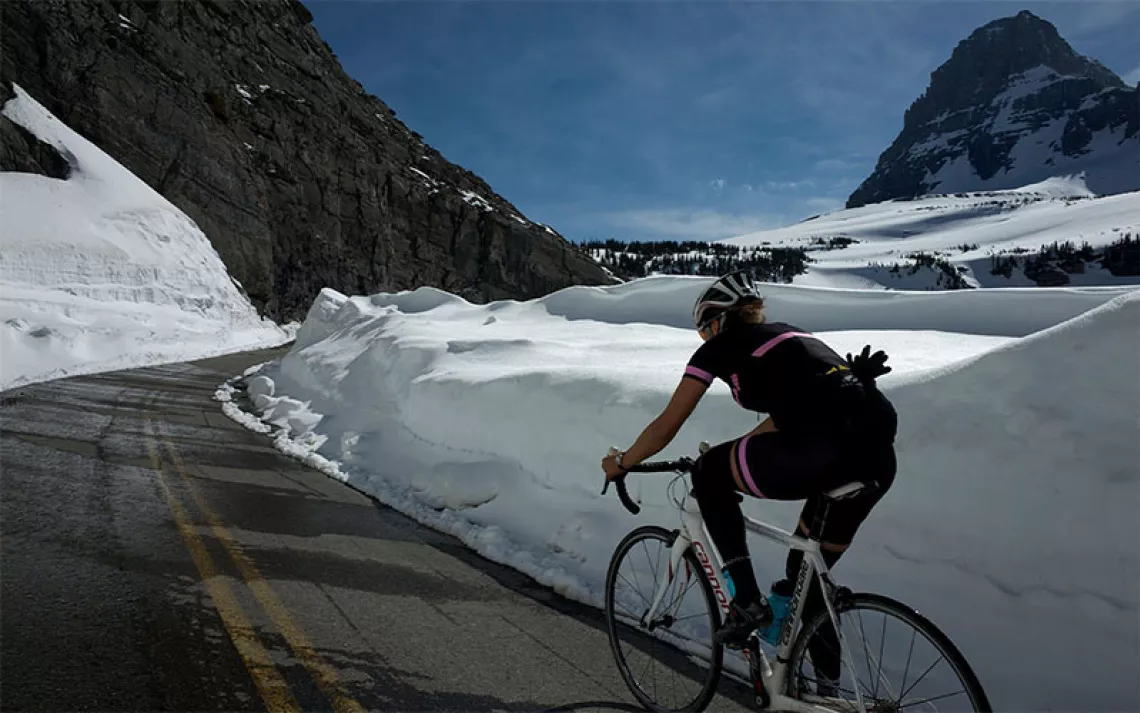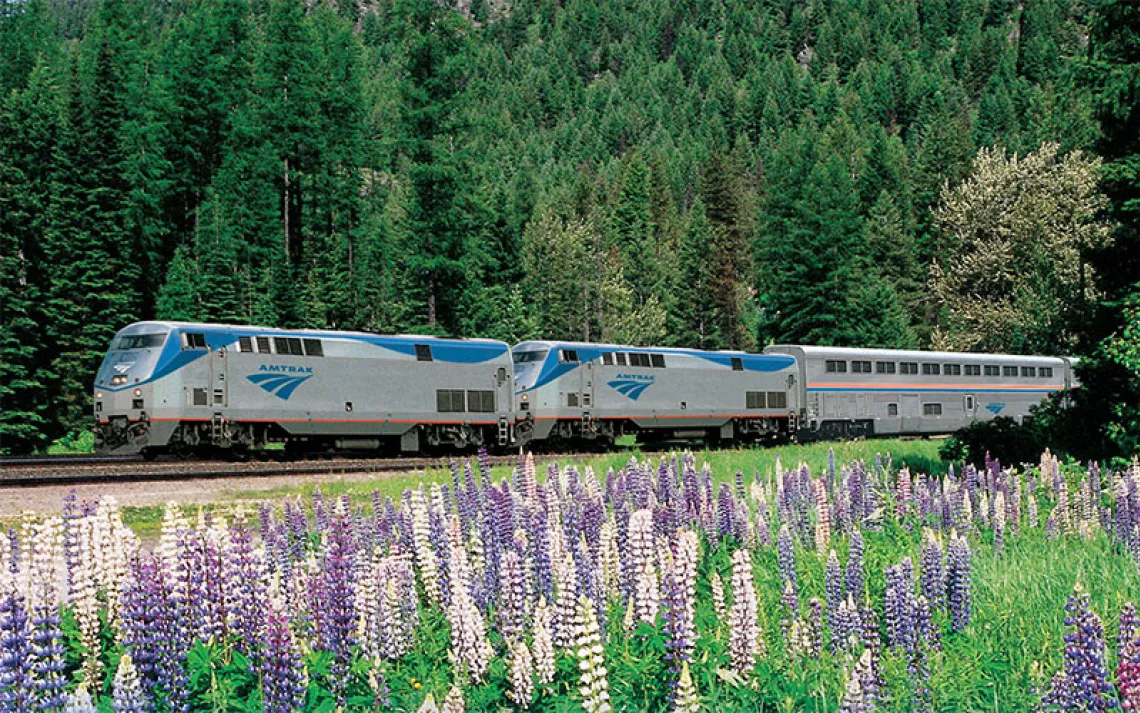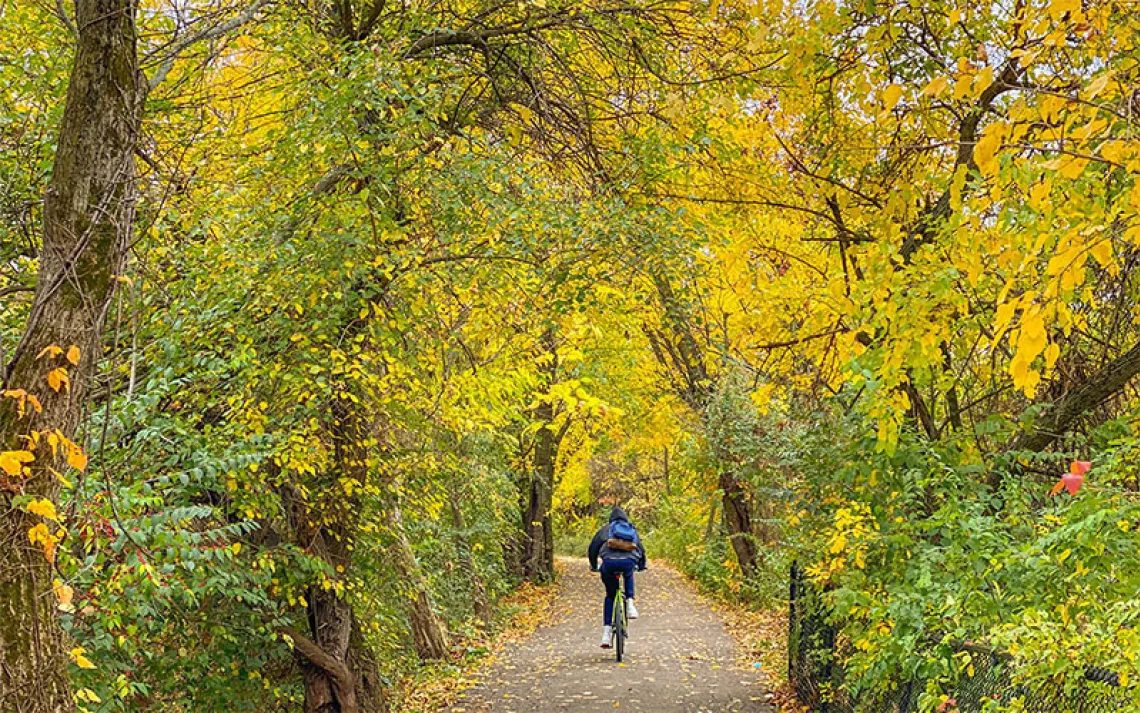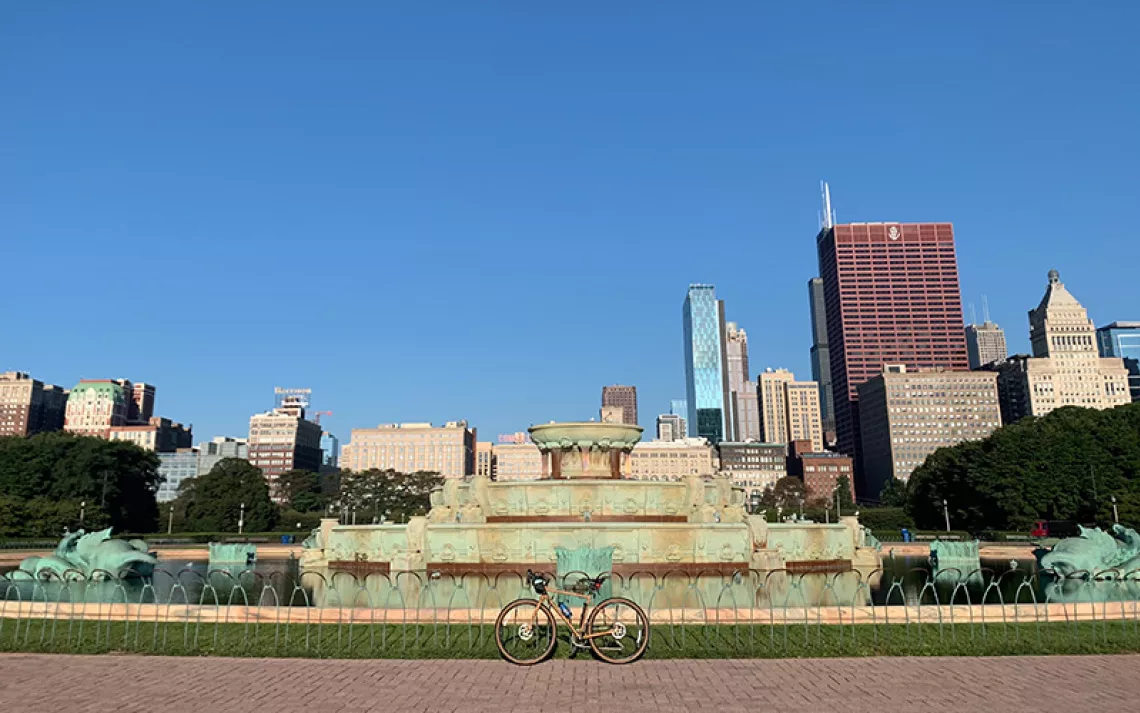Do Bikes Belong in Wilderness Areas?
No. But hikers and bikers must find a way to come together.
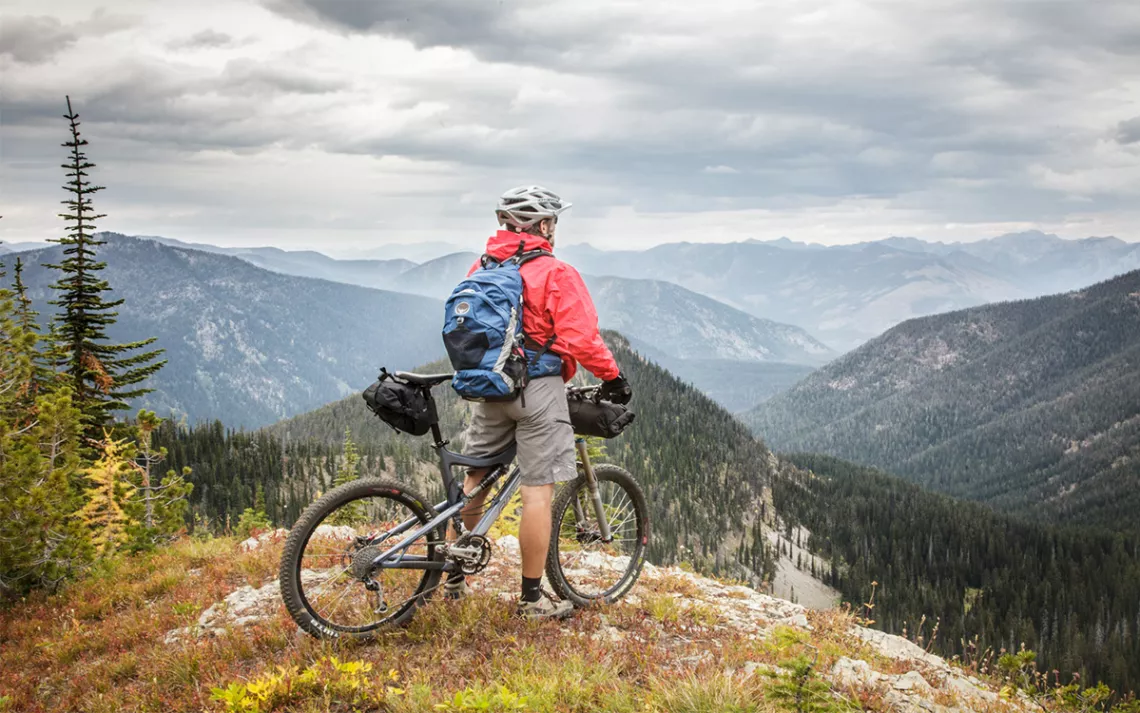
Montana, Whitefish Range | Photos by Aaron Teasdale
Wild country opened before me like a treasure chest. Matching the mountains to the lines on my topo map, I found a trail better suited to goats and climbed. On a ridgeline in the sky, I navigated talus slopes to an alpine summit where a golden eagle sat, taking in the world. It winged away and I assumed its perch, gazing across mountains beyond mountains, no other humans in sight.
I was in my early 20s, adventuring in the Whitefish Range of northern Montana and having one of my life’s formative backcountry experiences. For years I returned to this same remote area, entranced by its wildness, determined to explore every trail. Except I wasn’t hiking. I was mountain biking. My love affair was with the mountains and bears and raw ridgelines and eagles, but I relished the adventure and challenge of exploring them on two wheels.
This was in the early days of mountain biking, before much of the controversy over bicycles in wild places. Recently, the question of bikes in the backcountry has taken on a new urgency. On December 13, the House Natural Resources Committee voted 22-18 to move to the House floor a bill, HR 1349, sponsored by California Republican Tom McClintock that would allow bikes in wilderness areas. A companion bill, S.3205, has been introduced in the Senate. If passed, the bills would overturn the long-standing ban on bicycles in federally designated wilderness areas and give local land managers discretion to open trails they deem appropriate to bikes.
Wilderness activists are apoplectic at the thought of bicycles in areas that have long been reserved for only people and horses. The proposed bills, they say, are “a cynical and disingenuous move” to permit bikes in wilderness under the guise of increasing access for people in wheelchairs. Mountain bikers are irate at what they see as unfair restrictions. People on both sides are shouting past each other about “wildernuts” and “wreckreationists.” It’s not exactly constructive dialogue.
Given the biosphere-altering environmental threats we currently face, the whole controversy might seem a little parochial. But the debate over bikes in wilderness is more important than it might appear, because it gets to the core issue of how we humans relate to and experience the natural world. It’s also perilously divisive at a time when wild nature needs all the defenders it can get.
How did mountain bikers and hikers—both of whom reside in the big tent of outdoorspeople—come to such an internecine feud? And even more important—can we find common ground?

Montana, Ten Lakes
Two Legs Good, Two Wheels Bad?
Let me be 100 percent clear: Bikes should not be allowed in federal wilderness areas. There is no spot in the Lower 48 that is more than 22 miles from a road, and wilderness areas are one of the few places left for people on foot to find peace and escape modernity’s din.
But mountain bikers have a place in the backcountry as well. We conservationists need more, not fewer, allies in our efforts to protect wild places—and that will require hikers, backpackers, and other outdoor enthusiasts to make a fresh attempt to understand where bikers are coming from and what they want, too.
Wilderness is the most protective land designation in the United States. It can exist on any federal land—national forests, national parks, wildlife refuges, BLM properties—and can only be designated by an act of Congress. Within Wilderness (which I’ll differentiate from wild lands without the formal federal designation by capitalizing it) no motorized use of any kind is allowed—no Jeeps, no ATVs, not even chainsaws for trail clearing.
The Wilderness Act was passed in 1964 in response to the ever-increasing encroachment of roads and automobiles into America’s natural areas. Its defining statement is that Wilderness is “an area where the earth and its community of life are untrammeled by man, where man himself is a visitor who does not remain.”
George Nickas, executive director of Wilderness Watch, a sharp-fanged watchdog group, sums up the view of many when he describes the deeper ideals of Wilderness. “Wilderness says there is value beyond us out there,” he says. “The inherent sense that some places should be left alone, that restraint and respect for nature, is what the human species has to embrace for nature to flourish, and ultimately for humans to flourish, on this planet.”
“We can overrun Wildernesses if we want, but we’ve chosen not to,” he continues “Building that sense of restraint and respect, having the human species develop that, is essential to the preservation of the world.”
Such sentiments inspired the Wilderness Act’s ban on all “motorized equipment or motorboats . . . landing of aircraft [and] . . . other form[s] of mechanical transport.” While the prohibition on “mechanical transport” would appear to apply to bicycles, bikes are not explicitly mentioned in the law, since bicycles capable of traveling rugged trails didn’t yet exist. For decades, anyone who did try riding a bike on singletrack trails in Wilderness likely did so without official intervention. Then, in 1977, the US Forest Service, in response to the advent of mountain biking, made explicitly clear in its regulations that mountain bikes are a form of "mechanical transport," and banned them within its vast Wilderness lands. The other land management agencies soon followed suit.
Since the 1980s, mountain biking has exploded in popularity, and off-road biking is now nearly as popular as backpacking. According to the Outdoor Industry of America, there are 8.5 million mountain bikers in America, compared to about 10 million overnight backpackers (and 42 million day hikers). Far from the scruffy counter-culture types who birthed the sport, today’s mountain bikers are lawyers, doctors, mayors, even a president.
The growth in the popularity of mountain biking inevitably led to some conflict with hikers and equestrians, especially on popular trails near urban centers. This friction soon spread to the backcountry, with some Wilderness proponents accusing backcountry cyclists of selfishly viewing the natural world as nothing more than a personal gymnasium.
Some mountain bikers see the backpacking set as trying to kick them out of some of their most beloved places to ride. “I also love the fact that we have protected wilderness, but I draw the line when these proposals infringe upon some of the best mountain bike trails in the country,” one Oregon cyclist wrote in an online discussion about a proposed Crater Lake Wilderness that would boot bikes from several popular trails.
The tensions are at risk of worsening. Today there are 109 million acres of protected Wilderness in America. Wilderness advocates want to see much more. But many of the roadless areas suitable for Wilderness designation now have mountain bikers using them. And those cyclists—quiet, muscle-powered, outdoor lovers—are using their growing organizational might to ensure they can keep riding there.
Goal Interference
The dispute over bikes in Wilderness is, in part, an argument over aesthetics. When you’re hiking in the woods, you’re there to slow down, get close to nature, and find some peace in a hectic world. A mountain biker speeding around the bend can shatter that peace, leaving your nerves rattled and mood soured. Just knowing bikers could be coming around the corner can add an ambient tension to a hike. Mountain bikers often tell hikers that to avoid problems all they have to do is stay alert, but that state of perpetual vigilance interferes with our ability to relax and appreciate the natural world.
Hikers want peace and quiet. Bikers want challenge and adventure. Researchers call this “goal interference,” and it’s at the heart of the bikes and Wilderness debate.
It seems to this writer that both sides have their blind spots. Mountain bikers often underestimate the impact they have on the experience of hikers, much like ATV riders and snowmobilers don’t appreciate their impact on non-motorized users. Cyclists say, “We’re willing to share, why can’t hikers?” But when bike use on a trail becomes too heavy, many hikers abandon it. That’s not sharing—it’s displacement.
There’s a technological hierarchy of backcountry trail users, with the more mechanized negatively impacting the less mechanized. Social scientists call it an “asymmetric relationship.” The hierarchy goes something like 1. Hikers 2. Equestrians 3. Mountain bikers 4. Motorcycles/ATVs. The higher numbers typically don’t mind encountering the lower ones, but the reverse is not true, especially as the number of users increase. Canoeists hate motorboats. Skiers hate snowmobiles. Hikers hate mountain bikes.
This takes on another dimension in Wilderness, where hikers and equestrians go to have primitive experiences in a wild setting. I backpack every summer with my family. We exclusively go to Wilderness areas. Like other backcountry trail users, we’re seeking nowhere. But when you’re hiking, nowhere feels a little more like somewhere if bikes come rolling through.
Suddenly the vast, indomitable wilderness becomes smaller, more playground than sanctuary. The bicycle is a reminder of the fast-paced civilization we’re trying to leave behind. Not surprisingly, maybe, some backpackers even find their bliss busted by trail runners. As one online commenter wrote: “Once on a backpacking trip (and being quite far away from a trailhead) we came across trail runners who had started from their car that day!... It was weird to have the feeling that I wasn't really in a remote place, it just felt that way until the runners came along.”
By setting aside Wilderness, we are trying to protect wildlife habitat, intact ecosystems, and natural processes. But the truth is, this could be accomplished with other land designations that allow bikes. In Wilderness we’re also trying to protect an experience—of solitude, of wildness, of the primacy of nature. This is valuable: We need places where we move to the old rhythms.
Too many anti-bike Wilderness advocates seem hesitant to take a stand for this key point. Instead, they try to make an ecological argument against bikes in the wilderness. They would be more intellectually honest if they acknowledged their distaste for bikes on trails fuels much of their philosophical opposition to bikes in Wilderness. Because as it turns out, the ecological argument against bikes in Wilderness is relatively flimsy.

Montana, Whitefish Range
Leave No Trace
The burgeoning field of recreational ecology continues to reveal the many ways humans affect the natural world—but it hasn’t shown mountain bikers to be more impactful than hikers. Some studies even show that slower moving trail users, like hikers and cross-country skiers, can be more disruptive to wildlife than faster-moving trail users, who leave an area more quickly. Bikers also tend to be predictable, staying on trails rather than moving erratically and exploring off-trail the way hikers can. Conversely, mountain bikers can travel farther, giving them more opportunities to disturb wildlife (though on rugged backcountry terrain they cover less ground than some imagine, or about 10-20 miles in a day).
A debate also rages between activists on both sides of the issue over who has the biggest erosional impact on the trail itself. In this the science is somewhat clearer—a bike’s impact on trails is equal to a hiker’s, and both bikers and hikers create much less erosion than equestrians.
While this might seem a minor issue, it’s a key point in cyclists’ arsenal of arguments. How can bikes be accused of causing inordinate harm to Wilderness when equestrians, welcomed in virtually every Wilderness in America, cause more trail degradation and erosion?
Consider the recent backpacking trip I took with my family in Montana’s Absaroka-Beartooth Wilderness, on the border of Yellowstone National Park. The trail, popular with equestrians, was the width of a road and the soil was so churned by hooves it was like hiking on a beach. It was not my idea of a Wilderness experience.
Horses aside, the attempts to parse the erosional differences between Vibram soles and bicycle tires is where this debate goes off the rails. Trails themselves and our non-motorized modes of travel aren’t the major ecological issue of backcountry recreation. We are. No matter how we travel—foot, horse, bike—Homo sapiens are the ones importing invasive species, disturbing wildlife, and camping along the delicate shores of mountain lakes. Mountain bikers in particular often like to calculate their environmental impact solely by considering their effects on the trail itself. But mountain bikers, like all other trail users, need to realize their impact extends far beyond their contact with the soil.
I’m a case in point. I still mountain bike, but I also hike a lot. I love heading off trail in wild country with a pack full of camera gear to explore and look for wildlife sign—tracks, scat, kills, dens. The hard truth is that backcountry nature photographers—typically found tromping around prime habitat—have potentially much greater impact on wildlife than the typical mountain biker.
Yet if the average Wilderness advocate saw me in the woods—dressed in khaki, binoculars around my neck—they would greet me as another nature-loving ally, while a mountain biker might elicit their scorn for being an insensitive jock seeking to conquer the wild in a selfish quest for thrills.
Which gets to the nut of the issue: hikers simply don’t like encountering mountain bikers. And mountain bikers don’t have much patience for trying to understand why their beloved activity might spoil other people’s equally beloved activity.
Misunderstanding on a Two-Way Singletrack
Just as some people cherish meditation and quiet observation, there will always be those sporty humans who—genetically, psychologically—thrive on motion and adventure. What more healthful place for them to find challenge than nature? Many titans of conservation—think of John Muir, Bob Marshall, David Brower—were well known for their adventurous, athletic endeavors. Some conservationists have always started as outdoor funhogs before aging into a deeper type of nature appreciation and environmental advocacy.
Non-cyclists often imagine all mountain bikers as gonzo thrill seekers, skidding down mountainsides and flying through the air at terrifying speeds. But the reality is that on steep, rugged backcountry trails, mountain bikers typically travel slowly and carefully. The average speed of a backcountry trail ride is five or six miles per hour, or about two to three miles per hour faster than a hiker.
Aaron Clark, a longtime employee of The Wilderness Society who became the International Mountain Bike Association’s conservation manager in an effort bridge the divide between cyclists and hikers, says this style of riding, “Is like hiking with a bike, essentially. It’s a deep riding experience. It’s something our community wants desperately to preserve. A replacement for that is not to say, ‘Let’s build trails in the front country near this urban community.’”
Just as there are many different types of skiers—classic track, backwoods Nordic, Alpine, big mountain backcountry—there are many varieties of mountain biker. There’s a big difference between armor-clad cyclists streaking down a purpose-built bike park and the type of rider who heads deep into the backcountry under his own power. Backcountry cyclists often are also hikers, backpackers, and backcountry skiers. They carry food, water, maps, and emergency supplies on their backs, earning every mile with muscles and sweat. These are not the riders with poor etiquette going too fast on multi-use trails; nor are they the adrenaline-addled, trail-shredding mountain bikers seen in bike advertisements and videos.
We could have a more honest dialogue about where bikes are and are not appropriate if Wilderness advocates stopped misrepresenting the nature of backcountry mountain biking by using in their public education campaigns photos and videos of high-speed riders at lift-assisted ski areas on bike-specific downhill trails. This is akin to using a video of horses streaking around a racetrack to argue against equestrian use of the backcountry.
Mountain bikers are often accused of treating the natural world as a conquest, though there are certainly plenty of hikers with the same affliction. See, for example the hard chargers who race to complete the Appalachian Trail or Pacific Crest Trail in record times. (And don’t get me started on trail users with headphones in their ears, a sad display of nature disconnection that’s all too common among hikers, trail runners, and bikers alike). Although their interactions with wild nature are different and perhaps less intimate than those of hikers, mountain bikers experience more of the natural world around them then they’re often given credit for, especially on breaks when they appreciatively soak in their surroundings and scenery. While they may be in a perception bubble while riding, they’re also watching ecosystems, forests, waterways, and wildlife adapt and change with the terrain and seasons. If hikers are ecologists, mountain bikers are geographers. Both care deeply about the landscape.
Some conservationists who lament the growth of mountain biking urge cyclists to stay on our nation’s superabundance of roads. This ignores the fact that backwoods mountain bikers seek the same primitive, quiet, backcountry experience hikers do, away from motorized din. The entire sport of mountain biking is predicated on the pleasures of navigating narrow, “singletrack” trails. Telling mountain bikers to ride roads is like telling hikers to stay on sidewalks. It fundamentally misunderstands the activity.

Casey Greene, Idaho
A Question of Limited Space
All of that’s fine and good, you might say, but why do some mountain bikers insist on access to Wilderness? With so much other undeveloped, public land out there, why can’t they just ride in national forests or BLM properties that aren’t designated Wilderness? After all, only three percent of the continental U.S. is designated Wilderness, leaving much of the remaining 500 million acres of public land available for bikers. This is true—and it’s beside the point.
Hikers aren't interested in many of those lands because they’re full of roads and other scars of industrialization and motorized recreation. Mountain bikers, especially the expert, self-sufficient, backcountry riders relevant here, feel exactly the same way. They seek the same things hikers do: intact landscapes, scenic beauty, and exploration of wild places. These experiences are found in roadless landscapes, which make up about 170 million acres of our public lands. This is the acreage relevant to this debate.
In other words, the bikes-in-Wilderness debate often comes down to specific trails, in specific backcountry, roadless settings. When these larger issues move into people’s backyards, that’s when things get complicated and relationships become strained.
Nothing illustrates the challenges of Wilderness and bikes more than the Boulder and White Cloud Mountains of central Idaho. Bikes are not allowed in the 217,000-acre Sawtooth Wilderness, but backcountry cyclists have long prized the neighboring White Clouds for the wild scenery and solitude they offered. Wilderness designation for the area was first proposed decades ago, but it never went anywhere. Then, a few years ago, it seemed a new, broad-based solution was in reach when The Wilderness Society, Idaho Conservation League, and other conservation groups joined with the International Mountain Bicycling Association in support of a proposed 571,000-acre national monument that protected the land while allowing bicycling. In a joint statement, the groups asserted, “hiking, mountain biking, horseback riding, skiing and other forms of human-powered recreation are appropriate and important, and that a quiet backcountry experience for all human-powered recreation groups needs to be monitored, maintained, and protected.”
It appeared a long-sought model for collaborative, landscape-scale conservation planning that united the Wilderness and mountain bike communities had finally been found.
Except Idaho’s Republican congressional delegation wasn’t on board. Fearful of a national monument designation by President Obama, Representative Mike Simpson proposed three Wildernesses for the area, tortuously shaped to not impinge on popular motorized routes and protecting half as much area as the proposed monument. Boundary concessions were even made for heli-skiers. The legislation passed and President Obama signed it into law in August 2015. The Forest Service immediately began enforcing the bike ban in the new Wilderness areas. I was forced to cancel a bikepacking trip on Adventure Cycling Association’s Hot Springs Mountain Bike Route, a route that traversed the White Clouds and is now partially defunct.
The closure of once-cycled trails quickly, and inevitably, sparked outrage from many cyclists in Idaho and across the country. Bryan Leisle summed up the anger of many mountain bikers when he wrote, in one online forum: “I'm an Idahoan. I got screwed out of pristine mountain bike trails we've used for decades with the stroke of a pen when the White Clouds were designated Wilderness. Please tell me how after decades of use by mountain bikes, the White Clouds are magically now not compatible with bikes. This was the straw that broke the camel’s back. You zealots of Wilderness are creating enemies of a huge group of people that support the preservation and conservation of public land.”
This sort of rhetoric has become common among some mountain bikers. Here’s Montana mountain biker Lance Pysher, writing in (you guessed it) another online forum after 180 miles of trails were closed in the Bitterroot National Forest because they fell within wilderness study areas. “Stop trying to tame wilderness into an outdoor church of bowed heads where we engage in the fantasy that we are the first white people explore the land,” he wrote. “By limiting wilderness to merely being a place for quiet reflection, these wild lands are diminished to merely being a pretty place to camp. The wild is taken out of wilderness.”
For its part, the International Mountain Biking Association, which considers itself a conservation-minded organization, does not support bikes in Wilderness areas and favors cooperating with Wilderness advocates to draw boundaries for newly proposed Wilderness areas that maintain bike access to popular trails. IMBA maintains that stance today, even as it comes under intense pressure from many of its members who would like to be able to ride in Wilderness. In the wake of the Boulder-White Clouds Wilderness designation, for example, donations to the Sustainable Trails Coalition soared. That bikes-in-Wilderness legislation currently before Congress? It was drafted by the Sustainable Trails Coalition.
Whether or not you’re sympathetic to the complaints from mountain bikers, it’s important for conservationists to understand the frustrations of the mountain bike community. In recent years, cyclists have lost access to 110 miles of prized trails in the Mt. Hood National Forest, roughly half of the trail mileage open to bikes there. In Montana, mountain bikers have been booted from over 700 miles of trail in the last several years.
The trails in the Whitefish Range I described in my opening scene? The place where I first fell passionately in love with wild country, where I’ve literally encountered more bears than people on the trails? They’re now proposed for Wilderness and may soon be illegal to ride.
This is why mountain bikers are upset. Conservationists would do well to recognize this growing and increasingly powerful constituency. According to the Outdoor Industry Association, 22 percent of youths age 6-24 participate in cycling (though that figure includes road biking), while 15 percent participate in hiking (and only about a quarter of those or less are likely to backpack). Meanwhile the average age of visitors to Wilderness areas is rising. In one study of the Boundary Waters Wilderness, the age of the average visitor in 1969 was 26. In 1990 it was 36. In 2012 it was 46.
Simply put: It will be harder in the future to designate new Wilderness or complete large-scale land conservation initiatives without the support of mountain bikers.

Beartooth Mountains, Montana
Can’t We All Just Get Along?
Some public lands activists who have long been involved in the question of bikes in Wilderness believe that the divisions between bikers and hikers are overblown.
“I reject the notion that the recreation community and the conservation community are at odds with one another,” says Eric Melson, former program director for the Selway-Bitterroot Frank Church Foundation and current advocacy manager for IMBA. “I think that hiking is recreation, backpacking is recreation. You wouldn't have these protected areas if it weren't for the people that enjoyed them. You can't become an advocate for something like wilderness without going there and experiencing it.”
Mark Bettinger, a staff organizer with the Sierra Club who helped craft the organization’s policy on mountain bikes and has worked in partnership with IMBA, agrees. “In some ways it’s a distraction,” he says. “At the Sierra Club we want to get people out there in the woods—enjoy, explore, protect— and not everybody likes to hike. People like to get into the woods other ways. It’s healthy, it makes a better quality of life, it protects open space. Ninety percent of what we do, we agree on. But Wilderness gets in the way and causes conflict that is a distraction.”
And as George Nikas of Wilderness Watch points out, it’s not as if anyone is being kept from Wilderness recreation, which has always been an opt-in activity. Of Wilderness, he says, “It doesn’t discriminate against anyone. It doesn’t say I can go, but you can’t. It says if you or I choose to go, we have to go on foot or on horse. All mountain bikers can hike.”
Fair enough. But we need to ensure that mountain bikers have a place in wildlands as well.
With that vision in mind of focusing on the 90 percent that hikers and bikers agree on, mountain bikers and Wilderness advocates are increasingly, and successfully, partnering on landscape-scale conservation projects. In Colorado, cyclists joined with conservationists to protect over 100,000 acres of the Hermosa Creek watershed from energy extraction, preserving nonmotorized trails and designating a new Wilderness area. They did the same on Montana’s Rocky Mountain Front, creating a 200,000-acre Conservation Management Area that allows cycling adjacent to 67,000 acres of new Wilderness in the Bob Marshall Wilderness comple.
Mountain bike groups are currently supporting new Wilderness proposals in Colorado, North Carolina, Idaho, and Montana, often in conjunction with proposed “designated recreation areas.” The Blackfoot Clearwater Stewardship Project in Montana proposes to add 80,000 acres of Wilderness to the Bob Marshall Wilderness complex while creating a 3,000-acre recreation area focused on mountain biking. Some, if not all, mountain bikers are accepting losing access to trails in this instance because they have a seat at the table and their needs are not being ignored.
Such collaborations illustrate something important: The vast majority of both hikers and mountain bikers want more protected natural areas. We can squabble about which muscle-powered trail users have a greater impact, or we can work together to expand and improve protected areas for the benefit of all people and wildlife.
From my view as a longtime conservationist, backpacker, mountain biker, and Wilderness lover, the solution is to step back and take a new look at this controversy with eyes fresh and minds open. We need to stop demonizing others and respect the right of all nonmotorized users to experience nature in different ways. We must build trust and look at how we can create different, modern land management structures that offer stringent ecological protections while accommodating an evolving human user base.
If we want to re-envision what large-scale wildlands preservation and restoration can look like with non-motorized recreation as a primary use and biological integrity as a guiding principle, we need all lovers of wild nature at the table together. There are designations—recreation areas, primitive areas, conservation areas—that can provide nearly equal protection to Wilderness while allowing bicycles. Conservation doesn’t have to be a zero sum game.
Above all, we need to become more sensitive to the needs of other species, no matter how we’re traveling. This may mean closing key habitats during breeding seasons and important travel corridors during migration periods. Or it can mean creating core habitat zones with even stronger protections than Wilderness affords, like no human travel of any kind.
We’re never going to realize this vision without all outdoors-loving people working together. Because right now the people who care about Wilderness preservation and people who care about mountain biking are currently losing ground to people who don’t care about either.
This article has been updated since publication.
 The Magazine of The Sierra Club
The Magazine of The Sierra Club
